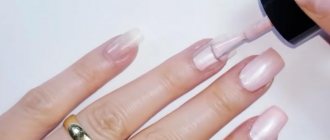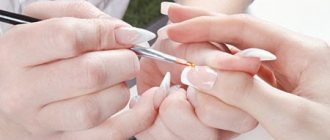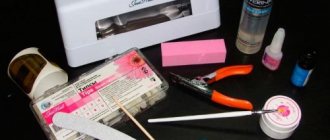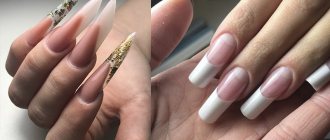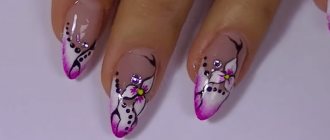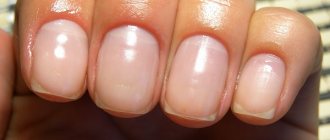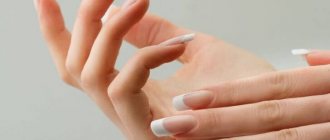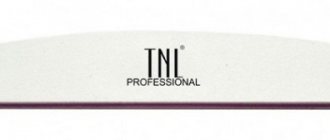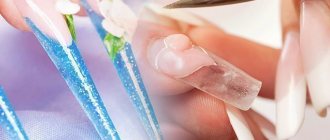In the summer, our feet are visible, no less often than our hands, so those girls who suffer from problems with the nail plate on their feet do not know how to look attractive in open shoes, but there is a way out - this is nail extension during pedicure, to give them beautiful shape and length. Most often, this procedure is offered in salons, but some women who are familiar with the extension technique do the same on their legs, on their own, at home. By resorting to this method of artificial turf, you will rid your toes of an unkempt appearance for a long time. This not only gives them beauty, but is also very convenient, since we all know that acrylic or gel is a very durable coating that lasts up to one month. Now all that remains is to figure out what is best to choose for toenail extensions during a pedicure, and also how to do it correctly without the help of a specialist?
Benefits of toenail extensions
Extending toenails will help hide defects such as:
- cracks;
- uneven nail surface;
- plate delamination;
- ingrown nails: with the help of extensions, the growth trajectory of the nail plate changes, which prevents ingrown nails;
- unsightly shape of nails, formed due to frequent wearing of uncomfortable shoes;
Due to uncomfortable shoes or poor quality socks, the nail plate can become deformed and take on an unaesthetic appearance. This procedure will also be an excellent solution for girls who cannot grow their nails due to their fragility. The material used for extensions is harder than the natural nail plate, it will prevent chips and cracks.
The artificial material is not sensitive to the negative effects of varnish, so the design can be changed frequently. Toenails do not grow quickly, so the material, when worn carefully, can last for more than a month, providing long-term well-groomed and aesthetically pleasing feet. Due to the smoothness of the coating, it is easier to decorate and treat extended nails than natural ones.
Extension of toenails, photo example. Finished nails are well varnished.
It is recommended to carry out corrections once every 4 weeks and not to remove the material yourself, as the first thin layer of the natural plate may be removed along with the synthetic coating.
Prosthetic method glue + canaline
This type of prosthetics is one of the most complex. The main advantage of this method is that the finished prosthesis looks natural, but at the same time it is much stronger than other nails.
As a rule, glue + canalin is used if the patient has suffered from serious fungal infections on the legs. The adhesive composition contains antifungal drugs. After applying this method, the patient is allowed to apply nail polishes, acetone and other decorative compounds.
How does the procedure work?
On the prepared nail plate, the specialist must first lay out glue in layers, and then canaline. The last component is a special natural material that allows fabrics to breathe. Depending on the thickness of the patient's natural nail, a different number of such layers may be required.
After this, you need to wait until the prosthesis hardens before it can be adjusted. It is performed using files, scissors and other equipment. The specialist must achieve such a result that the prosthesis matches the adjacent toenails or fingernails as closely as possible.
Upon completion of the procedure, the patient can go home immediately. There are no additional activities immediately after prosthetics, so you can do your usual activities.
Contraindications
Extending toenails has contraindications. It is necessary to refuse the extension procedure if there is a fungus, because due to the lack of access to the natural plate, it will be impossible to treat the disease; the fungus will begin to progress.
Small cuts or wounds are also a contraindication, so it is worth treating the cuticle 2 days before or after extensions. During chemotherapy or antibiotic treatment, you should also avoid artificial material on your nails, as the body produces acetone, which causes its rejection.
Extension can correct small cracks, but it cannot be carried out if a crack has formed in the nail matrix: this will provoke the development of infection in the growth area of the nail plate. Allergic reactions should be considered a special category of contraindications. Girls who are initially prone to allergies are at risk.
If after extensions your toes become red, itchy or swollen, the material must be removed immediately. It is recommended to test for an allergic reaction before starting the procedure: to do this, you need to apply a drop of the material on your wrist without polymerization.
Allergies occur due to substances contained in the gel consistency for correction and extension, agents that remove artificial material, and glue for fixing tips. Methacrylate is a synthetic component of materials for correction and design; it most often causes allergies during extensions.
Sensitivity to methacrylate and other allergens increases during pregnancy, as well as with diseases of the kidneys, thyroid gland, and liver. The reaction may appear throughout the body immediately or after several hours. People with sensitive skin should pay attention to the lamp for polymerizing the gel; allergies may also occur due to radiation.
What is the difference with extensions?
When doing nail extensions, a nail technician at a beauty salon uses acrylic, gel, and polygel as the main material (some even use fiberglass). However, such compositions are completely unsuitable for prosthetic procedures. The fact is that this is too non-plastic and dense raw material. Because of this, there is a lot of stress on the bed under the nail.
For the prosthetic procedure, which is performed exclusively by a doctor, special means of increased plasticity are used. Thanks to this, the prosthesis turns out to be as natural as possible, flexible and matches the natural nail not only in color, but also in texture.
That is, if you accidentally touch a surface with an extended gel or acrylic nail, it can cause serious pain, since the material is inelastic. If prosthetics are performed, such problems do not arise.
In addition, the prosthetic procedure allows you to wear artificial nails for quite a long time (up to 3 months). The material contains special components that prevent the formation of fungus or bacteria. If we are talking about regular extensions, then, as a rule, it is necessary to carry out correction and cleaning after 2-3 weeks.
Required materials and tools
The tools and materials needed to extend the nail plate at home are presented in the table. They are no different from the means that masters use. You should choose high-quality tools and materials, because the health and aesthetics of your nails depends on quality.
| Materials | Tools |
| Transparent base gel | Ultraviolet lamp 24 – 36 W |
| Gel for modeling and fixing | Files: rectangular and oval 100 – 180 grit |
| Primer | Pusher |
| Degreasing solution | Brushes with hard bristles, straight and tapered |
| Manicure glue | Four-way buff |
The gel hardens due to polymerization occurring under the influence of ultraviolet light, so a lamp is a necessary item. The polymerization time is related to the type of equipment, consistency and thickness of the coating. It is better to choose a lamp with a large working surface from a trusted manufacturer.
For independent use, you can purchase an inexpensive device with fluorescent lighting, for professional services - with an LED, since it is more durable with frequent use. After the gel has hardened, a cleanser is applied to remove the sticky part of the coating.
To prepare natural nails for the extension procedure, it is recommended to use ceramic or glass files.
It is better to process only artificial plates with iron tools. For natural nails, files with a hardness of 240 grit are used, for artificial nails - from 80 to 240 grit. When shaping the nail plate at the free edge, it is recommended to use oval files, at the cuticle - a boomerang shape, when polishing - rectangular files.
The buff is designed to work with both natural and artificial plates. All sides of this tool must have different hardness. The buff needs to be processed frequently, so polyethylene foam is suitable as a material. The tool is designed to smooth out unevenness of the nail plate, eliminate peeling and polish nails.
A pusher removes dead cuticle cells before applying gel polish. One end of the tool is shaped like a spatula, the other is shaped like an arrow. Stainless steel is suitable as a material. It is worth choosing a pusher with a grooved handle, as it will prevent your fingers from sliding over the tool, which means minor cuts.
To form a synthetic nail plate, you need straight and tapered brushes with hard bristles. The material must be synthetic. Before use, you need to check whether the bristles are firmly seated in the brush. It is recommended to remove dust that appears during processing of the coating with a synthetic manicure brush.
The gel can combine from one to three phases. Single-phase gel is used as a modeling agent, base, and finish. The two-phase system is designed for modeling and protection, used after the base. The three-phase product provides a base for a modeling coating and a finish. Using a camouflage finish in pastel shades will visually elongate the nail bed.
Nails that are properly applied look natural and do not require design; this material also hardens quickly in a lamp, which is why its popularity is growing. When giving length to nails, the material on which the gel will be applied is used. Forms made of hard paper or plastic are designed for this.
The paper form is attached under the natural nail plate, and the gel is laid out in a dense layer on top. The gel is laid out on plastic forms, then the material is applied to the natural nail. Manicure glue is necessary for nail extensions with tips. The tips are made of soft plastic, so they are easy to shape.
Before applying the base layer, a degreasing agent is applied to each nail: this ensures a tight fit of the artificial material to the natural plate and prevents peeling of the extended nails. Acid-free products delicately treat fragile nails, while acidic products open the nail scales.
Features of gel polish and polygel coating
Gel polish combines the properties of a corrective gel and decorative varnish. The coating is durable, hard, wearable, the product corrects imperfections, allows you to add length, and does not fade over time. You can remove gel polish using liquid or sawdust; an ultraviolet lamp is required to harden the product.
When applied to the nail plate, the product spreads in a thin layer, so it is sometimes difficult to control the contour of application. Despite the small thickness of the coating, it is difficult to hide regrowth areas. Gel polish allows air to pass through, which allows the nail cells under the coating to breathe.
Due to the need for polymerization in a lamp, the risk of developing a fungal infection during extensions becomes minimal, but burning and discomfort may be felt during irradiation. When processing or cutting off this coating with a manicure machine, light dust is generated, which can cause discomfort for the client and the master, so it is better to use a hood when working with this material.
Gel polish is a soft material that makes it easy to make corrections after extensions.
Toenail extensions can also be done with polygel. The consistency of this material resembles plasticine, so it is easy to control the border and shape of application: there is no risk of the material getting on the skin. You can extend nails using this material on both hands and feet. The material does not fade and retains color for the entire period of wear.
Polygel allows you to smooth out the application border; to do this, just stretch the material with a thin transparent layer using a brush. A special lamp is also required for hardening, but during polymerization there are no uncomfortable sensations. The polygel does not harden in air, which allows you to work with the mold for a long time.
When working with this material, a hood is no longer a necessary tool: when adjusting or removing, a small amount of heavy dust is formed, which is easily removed with a brush.
Polygel allows you to give your nails any shape, since the material is very soft and pliable, any mistake can be easily corrected with a file. This product can only be removed using a manicure machine. A significant advantage is hypoallergenic and odorless.
Advice from experienced manicurists
Gel nail extensions at home for beginners
A novice nail extension artist has plenty of opportunities to learn independently using video tutorials or articles on the Internet. It’s better to take real master classes from professionals. They can share their secrets and valuable information. Here are some of the tips:
- To create a three-dimensional design, polygel can be mixed with gel polish.
- To avoid detachment, when applying the material must be carefully pressed against the cuticle.
- The impermeable film created by gels, varnishes, and acrylics serves as a breeding ground for bacteria and fungi. Therefore, disinfection is necessary when using decorative coatings.
- You need to file your nails after they are completely dry. A wet nail plate is very vulnerable to mechanical stress and may begin to peel off.
- Nails need to be given periodic rest to recover, and not even use nail polish.
All stages of the process, from nail preparation to extension and design, are similar to techniques for working with gels and gel polishes. If you have the skill of building extensions with these materials, mastering the use of acrygel will not be difficult.
Step-by-step instructions for extending toenails at home
Before any nail treatment procedure, it is necessary to disinfect the tools: for this you can boil them or treat them with alcohol.
Technology:
- Next, start processing the nail plate. The cuticle must be trimmed, the nail disinfected and degreased. If there are any unevenness, the nail is polished with a buff; in case of chips, it is necessary to remove those parts of the nail plate that have moved away from the skin. If cuts appear on the skin during the treatment, extensions are done only after 2-3 days.
- It is necessary to coat your nails with a primer; it will eliminate the possibility of peeling off the gel or polygel.
- Attach the paper form under the nail. Carefully spread the material onto the plastic mold with a brush.
- The material is laid out on the form. When applying gel polish, precision and quick shaping of the material are required. When working with polygel, the brush with which the material is laid out must be constantly moistened with a degreaser so that the product does not stick to the pile. If the work is done with plastic forms, the material is laid out on a pattern and applied to the nail.
- Place your nails in a lamp to cure the coating. Average hardening time is 2 minutes.
- Carefully remove the forms from the artificial layer: to do this, you need to carefully pull them out.
- The shape and length of the artificial nail is adjusted with files and a buff. Sanding and leveling the surface are required.
- Apply color, create a design, dry finished nails in a lamp.
- Cover with finishing gel to prevent color fading. The finish is applied even if the previous step is missing.
If the coating is damaged, it is important to remove or repair it in time to prevent infection from getting inside. If the design on extended nails is done with a simple varnish, you cannot use liquids with acetone to remove or adjust the coating.
In order to preserve the color of your nail extensions, before applying regular polish, you need to apply a layer of clear polish or gel polish. It is better to remove the coating using a manicure machine, otherwise you can damage the natural nail.
Where can I get prosthetic nails done?
This procedure is performed in cosmetology clinics. It is best to contact a podiatrist, since he is a highly specialized specialist who has been trained in creating prosthetic nails for hands and feet.
In this case, prosthetics must be declared as a medical and not a cosmetic procedure. It is also worth clarifying that the master uses high quality materials, and the tools are suitable for this procedure.
Under no circumstances will a specialist use brushes, since they are not completely sterilized, and therefore there is a high risk of introducing fungus. During the work, the doctor can only use disposable spatulas.
Fashionable ideas for toenail extensions
Fashion design ideas appear every season, but they are not suitable for every girl. The design should be selected according to the shape and desired length of the nails.
Toenail Shapes:
- Square.
- Soft square.
- Rocker.
- Circle or oval.
- Trapezoid.
The length of the toenails should be comfortable, not causing discomfort or squeezing when wearing shoes. It is recommended to do French nails for any length of nails in square, rocker and trapezoid shapes. The main trends of this year are minimalism and monochrome.
A matte pedicure to match your suit and accessories will look very advantageous. You should not use too active decor in your image: elegant accents are preferable this season. For any shape of nails, a design made in gold or silver metallic is suitable; you can also try combining these colors in one design.
A pedicure in bed colors with a slight emphasis on the big toe is a stylish solution, but it is more suitable for people with a narrow plate, since a light tone can visually expand the nails. If you want to achieve the opposite effect, you should use a dark coating or a combination of a dark color at the edges and a light tone in the middle.
The amber and gradient trend is perfect for any nail shape, especially circle and trapezoid. You can also add light sparkles in the form of flakes at the base of the nail plate to this design. A gradient of glitter or iridescent flakes is especially popular.
Today, geometric solutions in pedicure are popular: these can be broken lines, clear figures, intertwined stripes, but you should choose only the thumb for such an accent. The most popular solutions today are white and red. This trend will help correct the circle, rocker and trapezoid shapes.
Foil of any color will help you create a geometric pattern: small figures made of this material on your nails look modern.
Trendy colors for this season: silver and gold, deep shades of red in a matte finish, white geometry, pastel colors in a matte finish. In bright pedicures, there is a tendency towards abstractionism, for example, chaotic multi-colored spots on a dark background.
"Gevol gel" for prosthetics
“Gevol gel” is a prosthetic mass that hardens under the influence of ultraviolet rays. Today this is one of the most popular methods of nail prosthetics. Gewol gel is applied to the surface of the nail from a tube. Then the specialist creates the desired nail shape. The gel hardens quickly (about 2 minutes) under the influence of a special ultraviolet lamp.
"Gevol gel" is used both to restore nails after fungus and as a preventive measure for the disease. This is especially true for those who often visit public places (swimming pool, gym, etc.) or plan a vacation in places with a humid, warm climate.
When to make a correction
The coating must be corrected in case of damage: cracks, chips. This will prevent infection from entering and developing. In case of pain, allergic reactions, itching or any discomfort, the extended nails must be removed. Reasons for correction also include fading, clouding or discoloration of the coating.
Optimal correction time without the above reasons: gel polish 3-4 weeks, polygel – a month. Nail extensions are a procedure that makes your look well-groomed and full. In the summer, beautiful toenails perfectly complement open shoes, and with careful wear, timely correction and high-quality work by the master, a pedicure can last the entire season.
Author: 00Lena
Article design: Oleg Lozinsky
